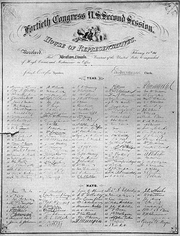The story of a world in which the Confederate states won their freedom and the tensions that follow..
Civil War[]
On November 13, 1861, the British mail packet Trent carrying two Confederate diplomats, James Mason and John Slidell arrived at London in the United Kingdom (then the most powerful nation in the world) to press the Confederacy’s case for diplomatic recognition by the main European powers (Britain and France). The two officials met with British foreign secretary John Russell and the French ambassador to the U.K. After various meetings the two countries agreed to aid the Confederacy, financially and militarily (The latter less so with France). The United states ambassador to Britain, Charles Francis Adams, Sr. was reported to have said to prime minister Henry John Temple, that they had made a "serious diplomatic error"

Confederate diplomats, John Slidell and James Murray Mason
By December of that year several divisions of British and (to a lesser extent) French soldiers landed at Charleston, South Carolina and a few weeks after that, the Anglo-French expeditionary force along with their Confederate allies clashed with the Union army just outside Walterboro in Colleton County, South Carolina
After two days the Confederate allies massacred the Union forces who hurriedly retreated, Abraham Lincoln had supposedly sent a letter to the British prime minister warning him about the effects foreign military action would cause, but the letter never reached London.

Battle of Walterboro
In an attempt to outflank their enemy the Union army attacked the Virginian city of Harrisonburg but were met by 5 divisions of Confederate and British troops the outnumbered Union army held out for a couple of weeks, but were eventually defeated by British colonel Alexander walker
Union Defeat[]
After numerous defeats Union leaders contemplated a diplomatic solution to end the war. The surrender of the entire western Union army was a powerful blow to the United states and after hearing that

Official surrender of the United States
the bulk of the Confederate army was less than 50 miles away from Washington D.C, President Lincoln sent his secretary of state, William H. Seward to meet with his Confederate counterpart Judah P. Benjamin in the fall of 1862 to discuss an end to the war and an overall solution to improve relations. On December 7, Seward signed the official surrender of the United states in the Confederate capital, Richmond.
After hearing of the surrender Jefferson Davis, President of the Confederate States made a speech announcing:
"Our secession is complete"
Reconstruction[]

The impeachment resolution signed by the House of Representatives.
A great deal of psychological rebuilding was important in reconstruction. The Confederate states' heavy reliance on
slavery was a blessing and a curse, because although slavery was helping the C.S rebuild economically many slaves fled to the United States. Lincoln wanted to reassure the confederate people that their private property was safe and that the U.S. government would help the Confederate soldiers who still remained in Union territory round up the escaped slaves. This angered many in the radical abolitionist factions of the Republican party who felt that Lincoln had lost touch with their partys' goal of emancipation, this would eventually lead to the impeachment of Abraham Lincoln. John C. Frémont, who many saw as the leader of the radical Republican movement proposed the impeachment, which occurred on May 13 1864 on the charges of "high crimes and misdemeanors" In all, 65 senators voted guilty, and 35 voted not guilty on the charge. On December 20 Lincoln was removed from office and Andrew Johnson was sworn in as president. After relentless attacks from republicans, Johnson was beaten in a landslide victory for the GOP and John C. Frémont was sworn in as president on March 4 of the following year.
Many people in the C.S. felt they had a duty to help their northern neighbour, President Davis and the confederate government created the "Money for the North" initiative, they hoped this would help mend relations with the U.S. but President Frémont's hardline position against the confederate nation was a huge hurdle. Frémont
convinced congress to eventually pass a law, called "Red stamp law" this prohibited the use of C.S. currency to aid the government. Various people felt this was a

The red stamp on this Confederate dollar bill reads "Remember where it came from"
foolhardy move which would halt reconstruction and so a month later Frémont's Secretary of state, Simon Cameron convinced the president that this C.S. money was their only hope, the money was grudgingly accepted but it was all marked with a "warning", reminding people that this money was the product of slave labour.
The Spanish-American War[]
By the 1890's the U.S. and C.S. were at relative peace, trade between the two nations was strong and the bitterness felt after the civil war had passed. Both countries had built up a strong navy and often conducted "friendship gestures", however tensions between the American countries and the Spanish empire were beginning to show, the U.S and especially the C.S. were sympathetic to the rebelling Cubans. As a token of goodwill the Confederate states sent a ship to send supplies to the rebels, the CSS Texas. The CSS Texas arrived in Havana on January 25, 1898. Her stay was uneventful until the following month. On February 15, 1898, at 9:40 p.m. the Texas sank in Havana harbour after an explosion, resulting in the deaths of 266 men. An American inquiry reported that it was caused by a mine. At the time the Spanish attributed the event to an internal explosion. Confederate newspapers instantly blamed the Spanish calling it an "act of war". Public support for military action against Spain increased until C.S. President Joseph Blackburn realised the benefits of a victory in such a war.
